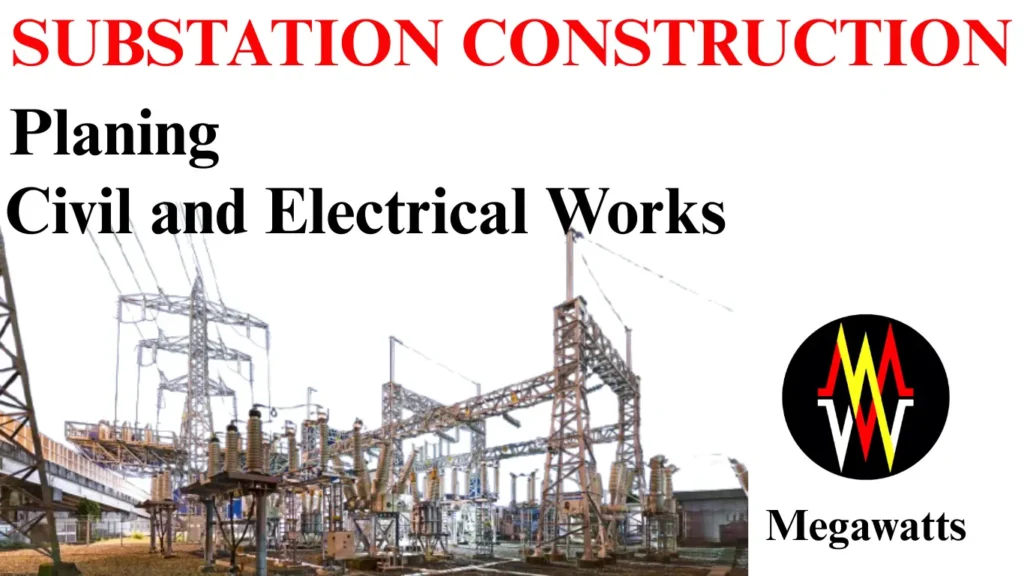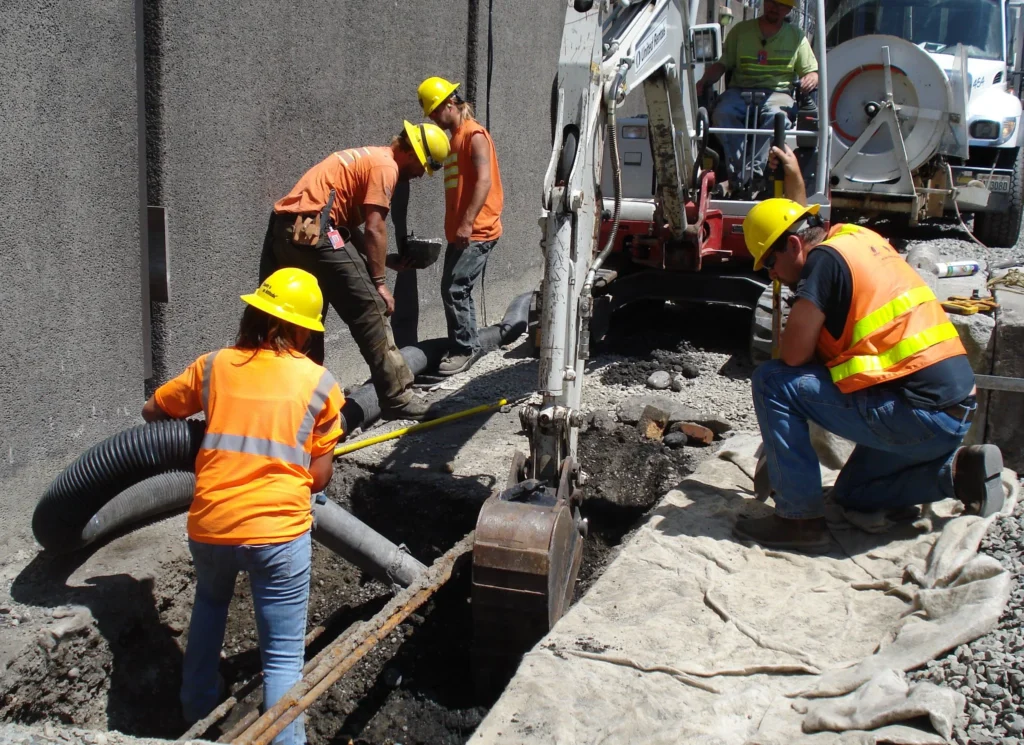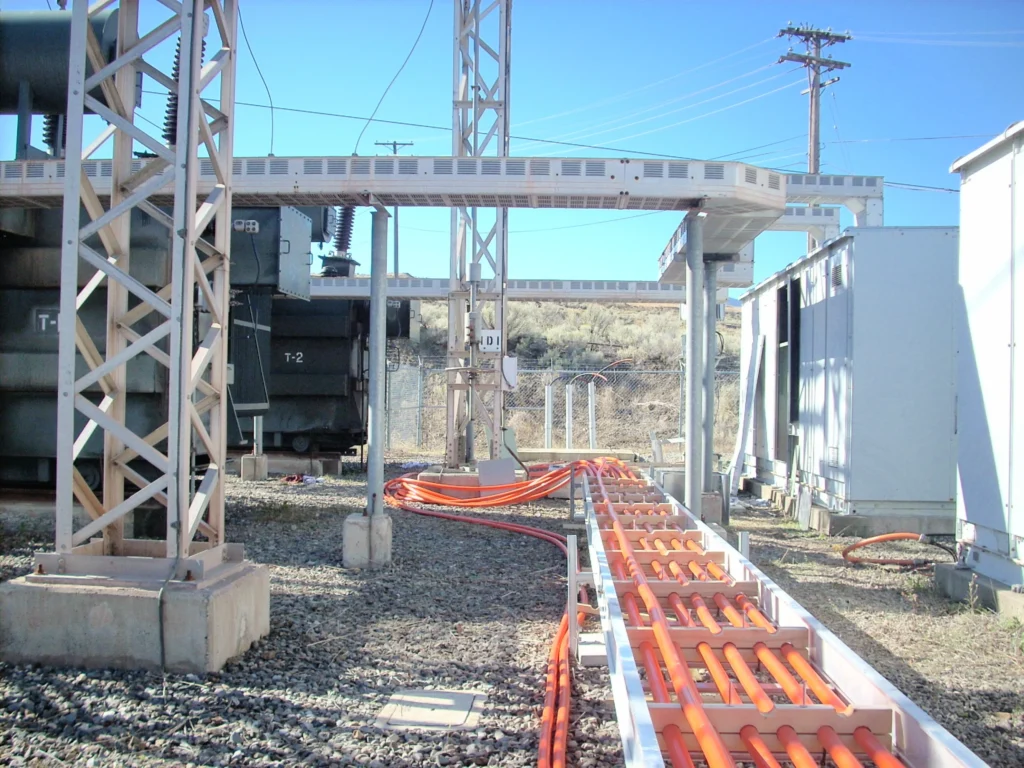
Substation construction is the building of an electrical substation, which is an essential part of a power system that connects the transmission network to the distribution network or generation to the transmission network.
Table of Contents
Substation construction involves civil works for the foundation of various electrical equipment and the control room building, electrical works that include the laying of various control and power conductors, and also their termination to various equipment.
Planning and Design phase of Substation construction
Substation construction requires meticulous planning beforehand. This phase includes
Site selection and feasibility study: This involves various factors, such as the site should be higher than the last highest flood level, it should be accessible by road for ease of transportation, for ease of proper orientation of bus and bay feeders, and the site is better if square or rectangular, as discussed in the previous article.
Consideration for the type of substation: AIS or GIS type substation to be chosen from feasibility study.
Substation layout planning: The layout planning of the substation is a very logical phenomenon, which includes the physical arrangement of all elements of the substation, bay, transformer, busbar arrangement, cable trench, control room, and roads represented on a single line diagram. The objective of layout planning is to ensure proper electrical clearance, ease of maintenance and testing, proper land utilization and also to assess plans for the future expansion.
Soil testing and Earthing Design
Soil tests are being carried out of the selected site to ensure proper earthing design and aid in civil or foundation design. Wenner’s four-pin method is commonly used as soil resistivity test where the resistivity is = 2πaR, where a is the gap between electrodes and R is the resistance measured. The soil resistivity gives out how effectively the fault current can be dissipated in the soil.
For tests related to Civil, the Standard Penetration Test or SPT checks the strength. Moisture content and density check the soil type, sand or clay, which determines the foundation design, raft or pile, or isolated footing type. The bearing capacity of soil test checks for the load-bearing capacity, whether it can support the transformer and other loads. If the bearing capacity is low, a deep foundation along with a pile is needed. Permeability and water table level tests are carried out as they affect the drainage and foundation type.
Regulatory Approvals and Compliance
The approvals are required for land acquisition, permission of land use, Electricity Regulatory Body approval, and environmental clearance if the line and substation site is in a forest corridor. Various compliances to standards like IEEE and IEC are needed for regulatory approval of the substation construction project.
Civil Works for Substation Construction
The substation construction starts with the clearing of the land and leveling of the ground. Fencing and boundary walls are generally made for the security of the construction site. The approach road to the substation is made for the movement of equipment and other building materials.

The soil is excavated as necessary for laying out the foundation of various switchgears, transformers, and gantry columns. Normally, M20 Concrete mix is used for the foundation; however, it can vary according to the design. RCC cable trenches, along with cover, are also made to house the power and control cables.
Soak pits for transformer oil are to be made near the transformer foundation. Rainwater drainage system has to be made to prevent waterlogging near the equipment. Rainwater harvesting pits are made, which are often mandated by regulation. Fire Walls between the power transformer have to be made for safety purposes as per regulations.
Excavation has to be made to lay the earth mat, which is basically GI flats at a definite depth of 1m. Also earth electrode has to be struck into the soil, followed by chemical treatment, especially to lower the earth resistance.
Control room and other auxiliary buildings, like the Diesel Generator shed, etc, have to be made, which will house various relays and control panels, batteries, and the DC system.
Electrical Works for Substation Construction
The various substation equipment are first received and unloaded at the site. The equipment are
physically tested as per its standard specification. The next step is the installation of the equipment into their respective foundations. The power transformer is placed in its foundation, and the bushing and radiators are assembled. The transformer oil is filtered from the barrels and filled inside the transformer after initially discharging the nitrogen and evacuating the transformer using a vacuum pump.
Likewise, the circuit breakers (gas/vacuum) are also installed in the respective foundation, assembled, and filled with gas and checked for leakage. The isolators, Current transformers, Potential Transformers, and Lightning arresters are all mounted on their foundation, and wiring is done, which is terminated in the control room at respective control panels. The busbar and all equipment in the switchyard are connected by conductors, strung, tensioned, and clamped in proper alignment. Also, the risers from the earth mat are connected to the structures of the equipment for earthing of the structure. For lightning protection, either earth wires run above the switchyard or protection is achieved by a lightning spike/mast as per the Direct stroke lightning protection calculation.
Power cables, control cables, and auxiliary cables run via the cable trench and are terminated in the control panel in the control room and junction boxes at the switchyard, where ferruling, glanding of panel and junction boxes are done, and lugs are fixed by a crimping tool in the cables for efficient connection.

Control and Relay panels are installed in the control room with associated meters and RTUs for the proper functioning of the SCADA (for remote monitoring and control). The substation DC system involves batteries and associated charger system installed in a separate room in the control room building. A washroom is often attached to the battery room to wash away any battery acid spill overs.
Station AC distribution and DC distribution panels are installed in the control room, which is used for switchyard lighting, building lighting, Air conditioning and to run other auxiliary systems of the substation.
Testing of all electrical equipment is done before the commissioning with high voltage testing equipment, insulation resistance tests, ten-delta tests for transformers, CTs, and PTs are done, Circuit Breaker timing Tests, contact resistance, and relay coordination tests are performed, and records are kept. The SCADA is integrated with the load dispatch center and tested for all control functions.
Various electrical work regulatory standards for Substation construction
| Electrical Work Items | Purpose | Standard / Codes |
|---|---|---|
| Power Transformer Erection | Voltage step-up/down | IEC 60076, IS 2026 |
| Circuit Breakers | Fault clearing | IEC 62271, IS 13118 |
| Isolators / Disconnectors | Provide isolation during maintenance | IEC 62271-102, IS 9921 |
| CTs & PTs | Metering and protection inputs | IEC 61869, IS 2705 |
| Lightning Arresters | Protection equipment from surges | IEC 60099, IS 3070 |
| Busbars & Gantry | Current distribution between feeders & transformers | IEC 60865, IS 5561 |
| Earthing System | Fault current dissipation, safety of personnel | IEEE 80, IS 3043 |
| Control & Relay Panels | Protection, automation, SCADA | IEC 60255, IS 3231 |
| Battery Banks & Chargers | Reliable DC supply to relays, breakers, and emergency lighting | IEC 60896, IS 1651 |
| Auxiliary AC/DC Power Supply | Operation of station auxiliaries | IS/IEC standards |
| Testing & Commissioning | Ensure reliability & safety of operation before energization | IEC 60060, IS 2071 |
Role of Substation Contractors in Substation Construction
The role includes approval of all detailed drawings of the substation construction from the owner and consulting with the consultant, equipment supplier, and the field manager to quickly sort out any issues in the construction.
The substation construction shall be in all aspects compliant with all regulatory standards; the contractor shall especially ensure this during the substation construction.
The contractor is responsible in many cases, as per the bidding, for the procurement and logistics of all the heavy electrical equipment, like transformers, CTs, and PTs, to the substation site.
The contractor is responsible for all the civil and electrical works discussed above. Also, he/she will be responsible for providing post-commissioning warranty and maintenance support, training for the operation of the installed equipment.
Substation construction Jobs and career
The substation jobs basically entail electrical engineers who can understand the basic working of all electrical equipment, along with the testing, maintenance, and installation of such. The civil engineers are basically responsible for overseeing or supervising the substation construction quality and aid in detailed substation foundation designs. All the structural and thermal loading checks are to be formally done by the mechanical engineers.
Other than the engineering jobs, skilled technician jobs are also important for any substation functioning, be it maintenance or operation. This job essentially includes changing conductors, operating circuit breakers, isolators, and earth switches. They normally have to climb heights and fix issues, check the tightness of all clamps and joints, and ensure no thermal hotspots are present.
Required Skill set and Degrees:
For engineering jobs, the required degrees are a graduation or diploma in Electrical, Mechanical, or Civil engineering discipline. For skilled technicians, it is the ITI Certificates of the relevant trade, like electrician, fitter, etc. Skills in CAD, ETAP, DIALUX, etc, help.
This article is a part of the page Substation Guide
